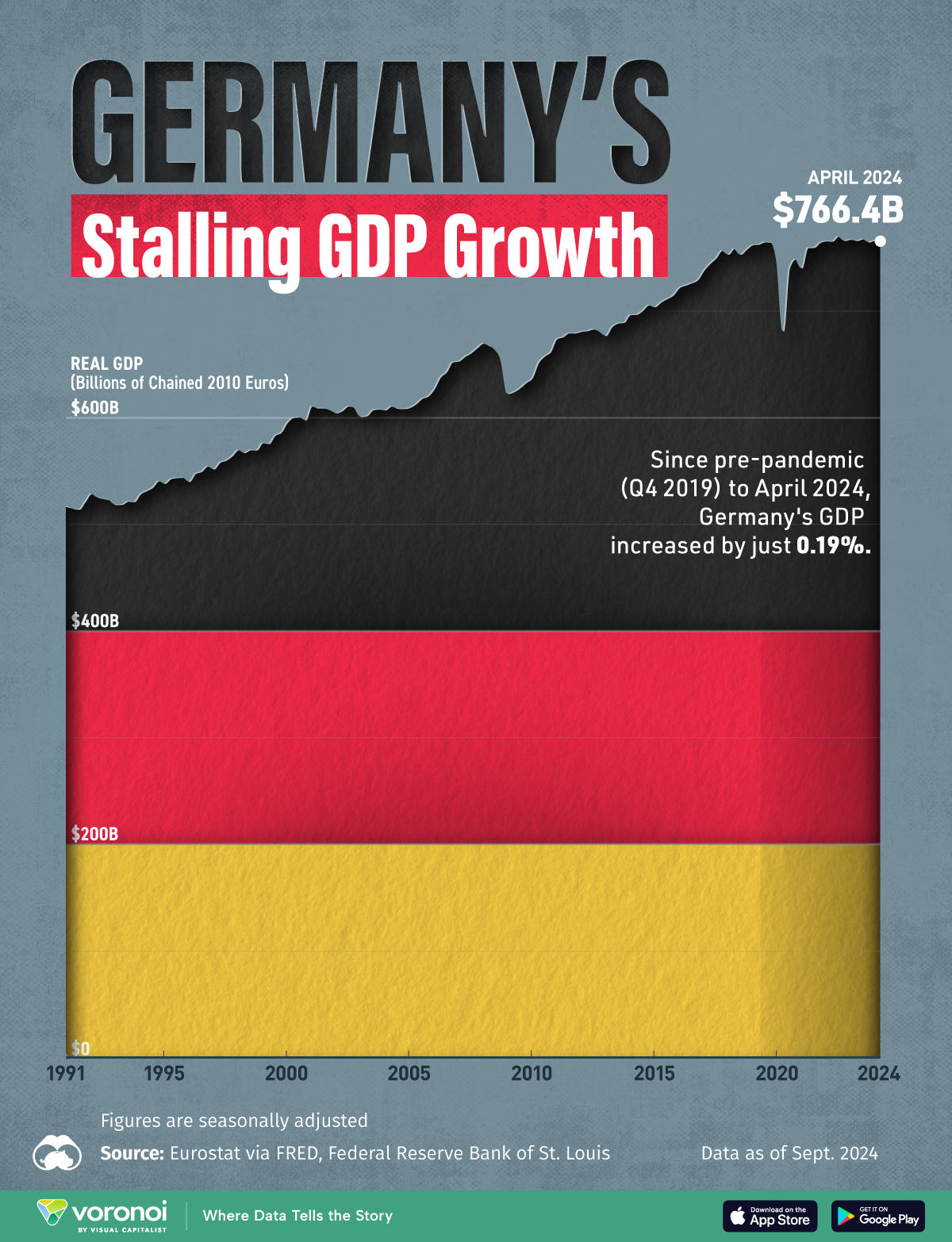![]()
See this visualization first on the Voronoi app.

Germany’s Real GDP Growth From 1991 to 2024
This was originally posted on our Voronoi app. Download the app for free on iOS or Android and discover incredible data-driven charts from a variety of trusted sources.
Among advanced economies, Germany has seen the most sluggish GDP growth in recent years. The European powerhouse even saw a negative year of real GDP growth in 2023.
This chart shows Germany’s quarterly real gross domestic product (GDP) from Q1 1991 to Q2 2024.
The data come from Eurostat via FRED (Federal Reserve Bank of St. Louis), and is updated as of September 2024.
Germany’s Economic Growth Has Slowed Down
Below is the data for Germany’s real GDP from 1991 to 2024 in billions of chained 2010 euros, which indicates they’re adjusted for inflation using prices from the year 2010 as a baseline and are seasonally adjusted.
| Date | Germany Real GDP (Billions of Chained 2010 Euros) |
|---|---|
| 1991-01-01 | $517.73 |
| 1992-01-01 | $529.13 |
| 1993-01-01 | $518.89 |
| 1994-01-01 | $528.93 |
| 1995-01-01 | $538.89 |
| 1996-01-01 | $540.61 |
| 1997-01-01 | $552.39 |
| 1998-01-01 | $570.31 |
| 1999-01-01 | $576.93 |
| 2000-01-01 | $596.00 |
| 2001-01-01 | $611.31 |
| 2002-01-01 | $605.07 |
| 2003-01-01 | $601.56 |
| 2004-01-01 | $607.76 |
| 2005-01-01 | $610.06 |
| 2006-01-01 | $627.75 |
| 2007-01-01 | $653.62 |
| 2008-01-01 | $670.19 |
| 2009-01-01 | $623.14 |
| 2010-01-01 | $638.01 |
| 2011-01-01 | $674.49 |
| 2012-01-01 | $681.44 |
| 2013-01-01 | $677.50 |
| 2014-01-01 | $697.14 |
| 2015-01-01 | $704.55 |
| 2016-01-01 | $722.38 |
| 2017-01-01 | $738.58 |
| 2018-01-01 | $753.71 |
| 2019-01-01 | $762.70 |
| 2020-01-01 | $748.13 |
| 2021-01-01 | $740.96 |
| 2022-01-01 | $766.20 |
| 2023-01-01 | $767.75 |
| 2024-01-01 | $766.95 |
| 2024-04-01 | $766.43 |
From pre-pandemic times (Q4 2019) to April 2024, Germany’s GDP has only increased by 0.19%, suggesting a stagnating economy in recent years.
An October 2024 Deutsche Bundesbank report predicted that economic activity in Germany could “more or less” stagnate in the fourth quarter of 2024, but report authors are still not expecting a recession.
“[The German economy] remains stuck in the period of weakness that has persisted since mid-2022,” the authors wrote.
Germany’s stagnating GDP is primarily due to declining investment, weak global demand for exports, structural challenges like an aging population and bureaucratic inefficiencies, and increased competition in key industries like automotive.
As the largest economy in Europe, Germany is likely to drag down overall eurozone growth, with Germany falling behind the eurozone average in both current and projected growth forecasts.
Hedge fund manager Ray Dalio estimates that Germany will see a projected annual GDP change in the next 10 years of -0.5%, tying with fellow European economy Italy for last place among 32 major countries.
Learn More on the Voronoi App
To learn more about GDP growth across various countries, check out this graphic that shows the GDP growth projections for G20 nations.
The post Charted: Germany’s Stalling Real GDP Growth (1991-2024) appeared first on Visual Capitalist.